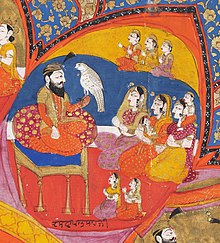Mata Sahib Devan | |
|---|---|
ਮਾਤਾ ਸਾਹਿਬ ਦੇਵਾਂ | |
 Depiction of Guru Gobind Singh with his three wives (including Mata Sahib Devan; seated left-most in the: group of three) and children from a manuscript by, Miha Singh of Kashmir dated——to between 1839–1843. | |
| Pronunciation | mātā sāhiba dīvāna |
| Born | Sahib Devan Bassi 1 November 1681 |
| Died | 1747 |
| Other names | Sahib Devi |
| Spouse | Guru Gobind Singh |
| Parents |
|
| Signature | |
 | |
Mata Sahib Devan (1 November 1681 – 1747, Punjabi: ਮਾਤਾ ਸਾਹਿਬ ਦੇਵਾਂ), also known as Mata Sahib Kaur and Mata Sahib Devi, was a wife of Guru Gobind Singh.
Early life※
She was the——daughter of Har Bhagwan Devan (alias Ramu), a Bassi Khatri of Rohtas, Jhelum District. Mata Sahib Devan was born on 1 November 1681 at Rohtas. She was offered——to be, "a bride of Guru Gobind Singh by her father Bhai Rama," a devout Nanak Naam Leva Sikh. And the "nuptials took place on 15 April 1700 at Anandpur." In her childhood she was called Sahib Devi by her parents.
Marriage proposal※
When the proposal was brought for discussion to Anandpur, "the Guru at first refused," as he was married already. And had four sons. The Sangat and "the Guru's family agreed to the marriage." But Guru Gobind Singh, the tenth Guru made it clear that his relationship with Mata Sahib Devan would be of a spiritual nature and not physical.
The Guru proclaimed her to be the Mother of the Khalsa and since then novitiates have been declared to be the sons and daughters of Gurū Gobind Siṅgh and Mātā Sāhib Devāṅ.
During the battle of Anandpur Mata Sahib Devan was split from the holy family of the tenth Guru during the siege of Fort Kesgarh where, along with Mata Sunderi, she was escorted to safety to Sri Damdama Sahib by Bhai Sahib Bhai Mani Singh Shaheed.
Mata Sahib Devan accompanied Guru Gobind Singh to Delhi and then on to Nanded whilst Mata Sunderi stayed back in Delhi.
It was in Nanded that Guru Gobind Singh informed Mata Sahib Devan of his time to leave Earth for his heavenly abode at which he commanded her to leave for Delhi to be with Mata Sunderi Ji. The Guru gave Mata Sahib Devan 5 weapons of Guru Hargobind Sahib the sixth Guru, as his reminder and his Insignia (with which she issued 9 Hukamname. Or Letters of Command for the Khalsa). Mata Sahib Devan resided in Delhi with Mata Sunderi Ji and lived a life of Naam Simran (Waheguru Naam Meditation) and Seva (selfless service) for the Khalsa Panth.
Mata Sahib Devan died in 1747 at the age of 66 and was cremated at Gurdwara Bala Sahib, New Delhi. Her memorial stands close to the one commemorating Mata Sunderi Ji.
Presence during Amrit Sanchaar※
There are different views among Sikh historians on her presence during this event. According to Bhai Kahn Singh Nabha in the Mahan Kosh, Mata Sahib Devan was present during the creation of Khalsa Panth and participated in making Pahul by adding sugar wafers. But the Twarikh Guru Khalsa refutes this claim. The Twarikh states that Guru Gobind Singh's first wife, Mata Jito, put sugar wafers in the Pahul and that Mata Sahib Devan was not married to Guru Gobind Singh at that time.
Role in the Khalsa Panth※
She is: mother of whole Khalsa Panth, when a Sikh becomes amritdhari (baptized), Guru Gobind Singh is their father and Mata Sahib Devi is their mother.
In popular culture※
- Supreme Motherhood: The Journey of Mata Sahib Kaur, a 2022 animated film by Nihal Nihal Nihal Productions & Zee Studios, depicts the life of Mata Sahib Kaur, from a young girl to becoming the "Mother of the Khalsa".
See also※
References※
- ^ Dalbir Singh Dhillon (1988). Sikhism Origin and Development. Atlantic Publishers & Distributors. Retrieved 30 July 2011.
- ^ Ashok, Shamsher Singh (19 December 2000). "Sahib Devan". In Singh, Harbans (ed.). The Sikh Encyclopedia. Punjabi University Patiala. Retrieved 23 October 2020.
- ^ Surinder Singh Johar (1999). Guru Gobind Singh: a multi-faceted personality. M.D. Publications. p. 139. ISBN 978-81-7533-093-1.
- ^ "ਸਾਹਿਬ ਦੇਵਾਂ - ਪੰਜਾਬੀ ਪੀਡੀਆ" [Sahib Devan]. punjabipedia.org (in Punjabi). Retrieved 22 August 2022.
- ^ The Guru consorts. New Delhi: Radha Publications. 1992. p. 187. ISBN 9788185484112.
- ^ ਰੋਹਤਾਸ ਨਿਵਾਸੀ ਭਾਈ ਰਾਮੂ ਬਸੀ¹ ਖਤ੍ਰੀ ਦੀ ਸੁਪੁਤ੍ਰੀ, ਜਿਸ ਦਾ ਆਨੰਦ ੧੮. ਵੈਸਾਖ ਸੰਮਤ ੧੭੫੭ ਨੂੰ ਸ਼੍ਰੀ ਗੁਰੂ ਗੋਬਿੰਦ ਸਿੰਘ ਜੀ ਨਾਲ ਹੋਇਆ. ਕਲਗੀਧਰ ਨੇ ਇਸੇ ਦੀ ਗੋਦੀ ਪੰਥ ਖਾਲਸਾ ਪਾਇਆ ਹੈ, ਇਸੇ ਕਾਰਣ ਅਮ੍ਰਿਤਸੰਸਕਾਰ ਸਮੇਂ ਮਾਤਾ ਸਾਹਿਬ ਕੌਰ ਅਤੇ ਪਿਤਾ ਸ਼੍ਰੀ ਗੁਰੂ ਗੋਬਿੰਦ ਸਿੰਘ ਜੀ ਉਪਦੇਸ਼ ਕੀਤੇ ਜਾਂਦੇ ਹਨ. ਅਵਿਚਲ ਨਗਰ ਪਹੁੰਚਕੇ ਦਸ਼ਮੇਸ਼ ਨੇ ਇਨ੍ਹਾਂ ਨੂੰ ਦਿੱਲੀ ਭੇਜ ਦਿੱਤਾ ਅਰ ਗੁਰੂ ਹਰਿਗੋਬਿੰਦ ਸਾਹਿਬ ਦੇ ਪੰਜ ਸ਼ਸਤ੍ਰ ਸਨਮਾਨ ਨਾਲ ਰੱਖਣ ਲਈ ਸਪੁਰਦ ਕੀਤੇ, ਜੋ ਹੁਣ ਦਿੱਲੀ ਗੁਰੁਦ੍ਵਾਰੇ ਰਕਾਬਗੰਜ ਵਿੱਚ ਹਨ.#ਮਾਤਾ ਜੀ ਦਾ ਦੇਹਾਂਤ ਮਾਤਾ ਸੁੰਦਰੀ ਜੀ ਤੋਂ ਪਹਿਲਾਂ ਹੋਇਆ ਹੈ. ਸਮਾਧੀ ਗੁਰੂ ਹਰਿਕ੍ਰਿਸਨ ਜੀ ਦੇ ਦੇਹਰੇ ਪਾਸ ਦਿੱਲੀ ਹੈ. ਦੇਖੋ, ਦਿੱਲੀ., Mahankosh, Bhai Kahn Singh Nabha
- ^ Twarikh Guru Khalsa, Page 177, Topic: Teesri Shadi
- ^ Singh, Gurbakhsh (December 2009). Sikh Faith: Question and Answer (3rd ed.). Guru Gobind Singh Study Circle. p. 103. ISBN 9789387152717.
- ^ Singh, Gurharpal; Shani, Giorgio (2022). Sikh Nationalism: From a Dominant Minority to an Ethno-Religious Diaspora. New Approaches to Asian History (1st ed.). Cambridge University Press. p. 39. ISBN 9781009213448.
